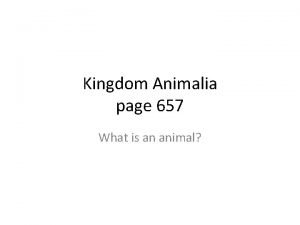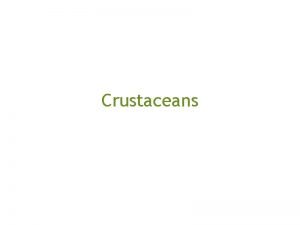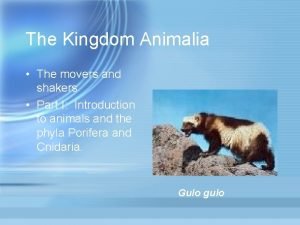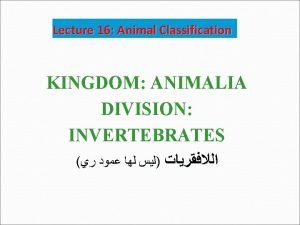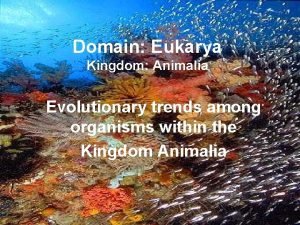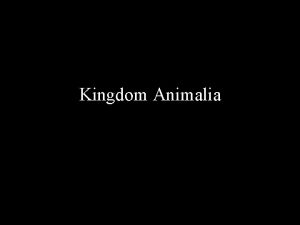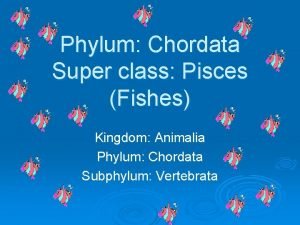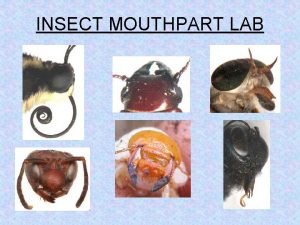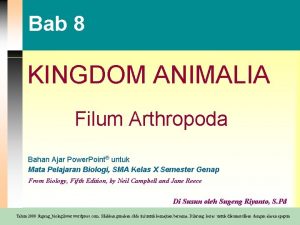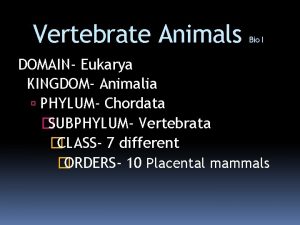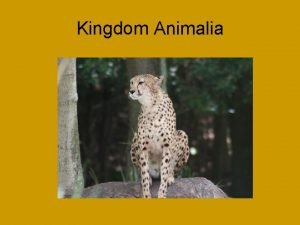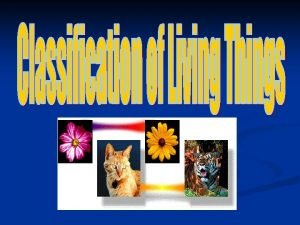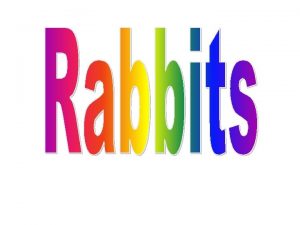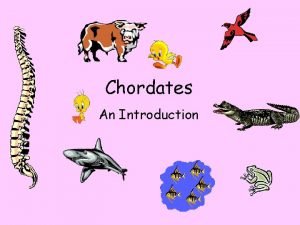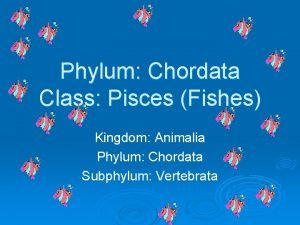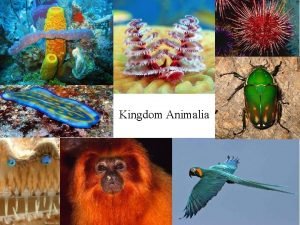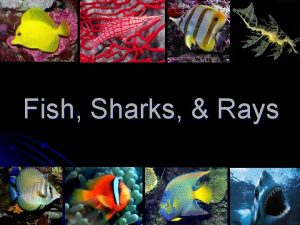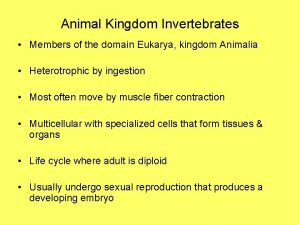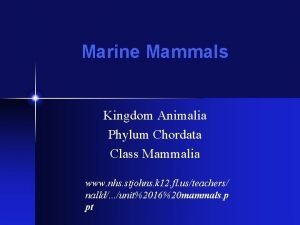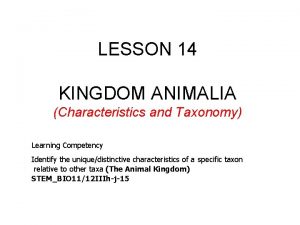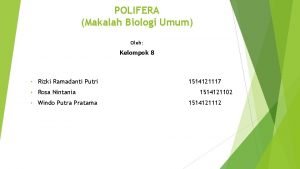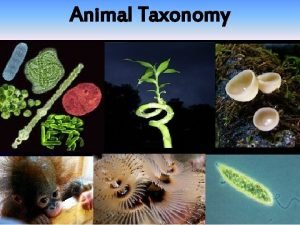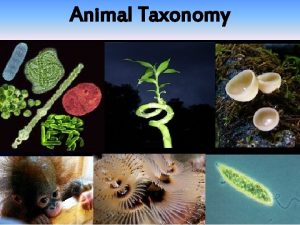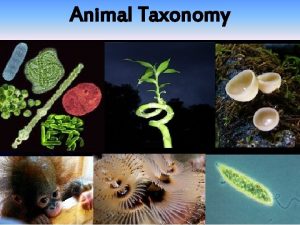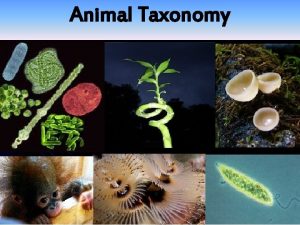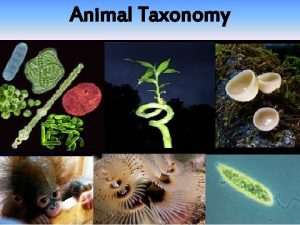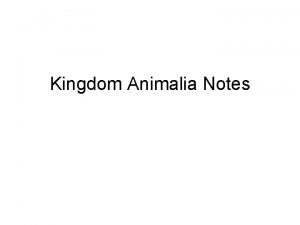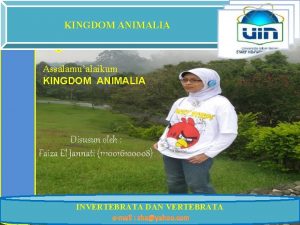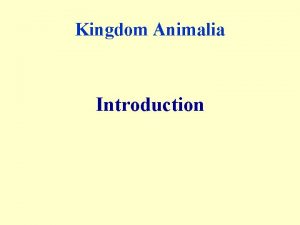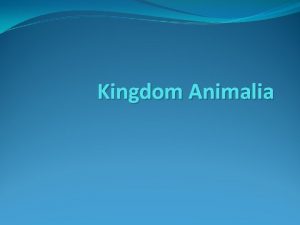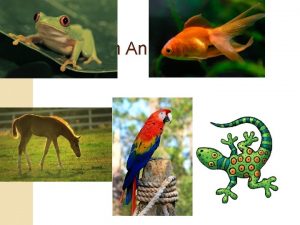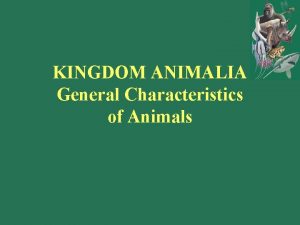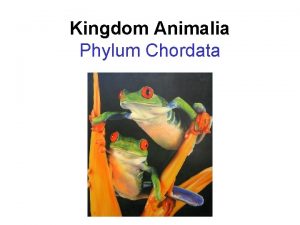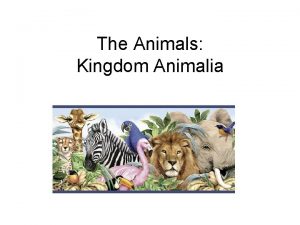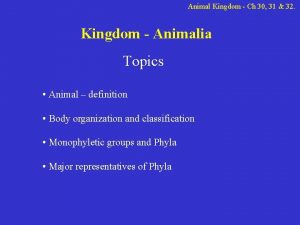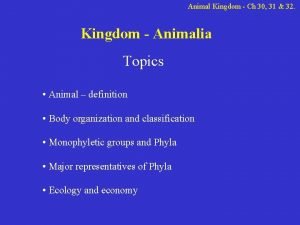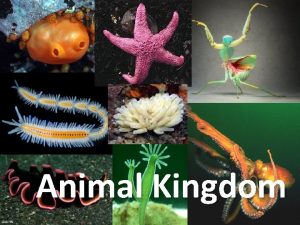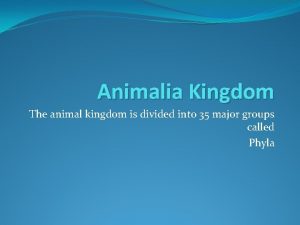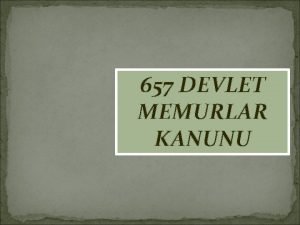Kingdom Animalia page 657 What is an animal



























- Slides: 27

Kingdom Animalia page 657 What is an animal?

What are characteristics of animals? • http: //www. youtube. com/watch? v=Gw 0 FU 73 3 zzg

Characteristics of animals 1. Multicellular – Different cells specialize to perform certain functions – the more evolved the higher the degree of specialization – As specialization increases, so does complexity and this enables animals to adjust better to their environments.

Degree of specialization a. Cells which are grouped together to form b. Tissues such as blood, bone, muscle, nerve c. Organs: liver, stomach d. Organ systems: circulatory, digestive, reproductive

Characteristics continued 2. Eukaryotic 3. Heterotrophic - ingest and then digest inside body 4. Most are motile (All are motile for at least part of their life cycles)

Characteristics continued 5. Phyla in the animal kingdom are classified according to evolutionary development. a. 2 subkingdoms: parazoa (less evolved) and metazoa

b. Also grouped by whether they are: vertebrates or

invertebrates (95%)

Animals carry out the following essential functions and each has adaptations which allow it to do so: • Feeding – Ingest – herbivores, carnivores, omnivores • Respiration – Oxygen in; carbon dioxide out

• Circulation – Diffusion in small, aquatic – Larger animals have a circulatory system.

• Excretion – Main waste product of cells is ammonia (contains nitrogen) – Most animals have an excretory system that eliminates ammonia or changes it into a less toxic substance and then gets rid of it.

• Response – Respond to events in their environments using specialized nerve cells. – Range from no nerve cells to cephalization to extremely specialized nervous system

• Movement – Majority of animals are motile (capture food) – Some may be sessile as adults but move in early development. – When sessile, they attach themselves to a spot and capture food as it passes by.

• Reproduction – Sexual (haploid gametes) which maintains genetic diversity – Some are hermaphrodites – In some cases, may be asexual, which allows for rapid reproduction

Also see page 660

Early development – page 661 • Zygote = fertilized egg • Blastula = hollow ball of cells • Blastopore = blastula folds in on itself, creating a tube which becomes the digestive tract.

• The zygote undergoes a series of divisions to form a blastula, a hollow ball of cells. Copyright Pearson Prentice Hall

• A protostome is an animal whose mouth is formed from the blastopore. • Most invertebrate animals are protostomes. Ectoderm Mesoderm Endoderm Blastopore Anus Blastopore becomes mouth Copyright Pearson Prentice Hall

Ectoderm. Evolution Trends in Animal • A deuterostome is an Mesoderm animal whose anus is Endoderm formed from the Blastopore blastopore. • The anus is the opening through which wastes leave the digestive tract. Mouth Blastopore becomes anus Copyright Pearson Prentice Hall

Trends in Animal Evolution • Echinoderms and vertebrates are both deuterostomes. Copyright Pearson Prentice Hall

Cells differentiate into three layers called germ cells. • Endoderm = inner layer, develops into linings of digestive tract and respiratory system. • Mesoderm = middle layer which gives rise to muscles and much of the circulatory, reproductive and excretory systems. • Ectoderm = outer layer gives rise to sense organs, nerves, and the outer layer of skin.

Trends in Animal Evolution • The cells of the endoderm, or innermost germ layer, develop into the linings of the digestive tract and much of the respiratory system. Only the label “endoderm” should appear on this slide. Endoderm Copyright Pearson Prentice Hall

Trends in Animal Evolution • The cells of the mesoderm, or middle layer, develop into muscles and much of the circulatory, reproductive, and excretory organ systems. Mesoderm Copyright Pearson Prentice Hall

Trends in Animal Evolution • The ectoderm, or outermost layer, develops into the sense organs, nerves, and the outer layer of the skin. Ectoderm Copyright Pearson Prentice Hall

Radial Symmetry

Bilateral symmetry

 An animal whose mouth is formed from the blastopore
An animal whose mouth is formed from the blastopore Domain eukarya, kingdom animalia (or animal)
Domain eukarya, kingdom animalia (or animal) Old kingdom middle kingdom new kingdom
Old kingdom middle kingdom new kingdom Old kingdom middle kingdom new kingdom
Old kingdom middle kingdom new kingdom Mentohotep
Mentohotep Old kingdom middle kingdom new kingdom
Old kingdom middle kingdom new kingdom Kingdom animalia phylum arthropoda
Kingdom animalia phylum arthropoda Nine phyla of kingdom animalia
Nine phyla of kingdom animalia Karakteristik animalia
Karakteristik animalia Coelom
Coelom Kingdom animalia cladogram
Kingdom animalia cladogram Lackcell
Lackcell Pisces chordata
Pisces chordata Animalia kingdom
Animalia kingdom Ciri insecta
Ciri insecta Domain eukarya kingdom animalia
Domain eukarya kingdom animalia Animalia characteristics
Animalia characteristics Kingdom animalia contains 350 000 species of what
Kingdom animalia contains 350 000 species of what Kingdom animalia cell structure
Kingdom animalia cell structure Entertoxemia
Entertoxemia Animalia kingdom chordates and vertebrates
Animalia kingdom chordates and vertebrates Kingdom animalia pisces
Kingdom animalia pisces Kingdom animalia organisms
Kingdom animalia organisms Kingdom animalia fish
Kingdom animalia fish Which are all members of the domain eukarya
Which are all members of the domain eukarya Kingdom animalia phylum chordata
Kingdom animalia phylum chordata Mammals characteristics
Mammals characteristics Makalah kingdom animalia
Makalah kingdom animalia
